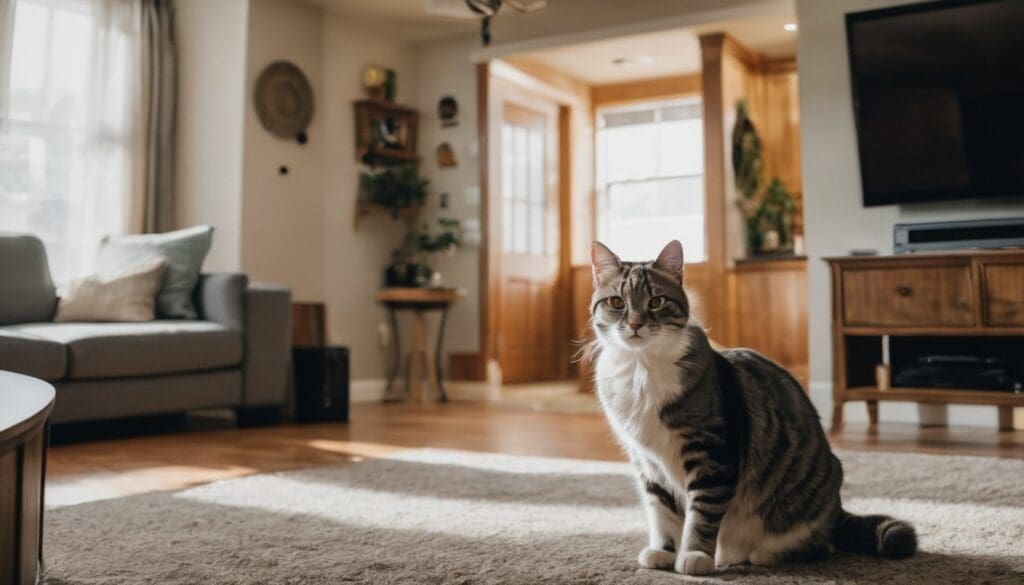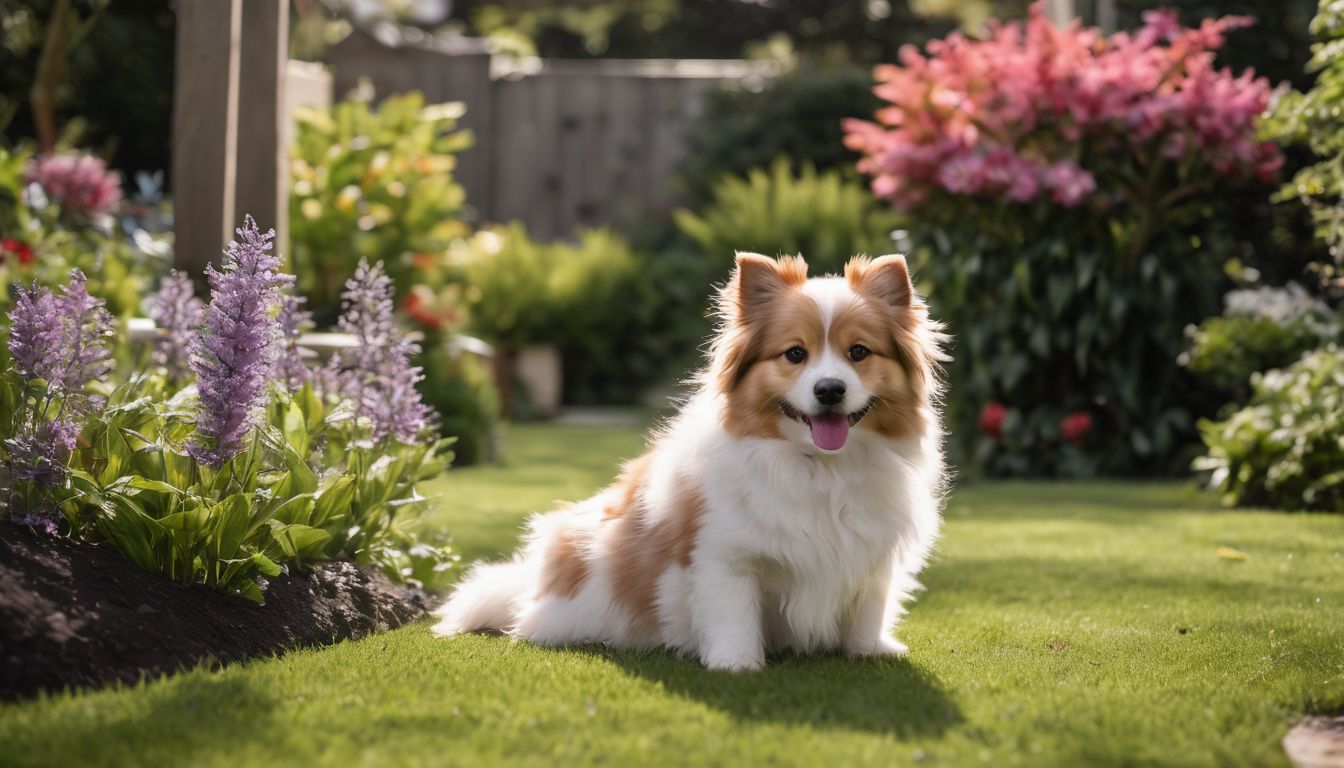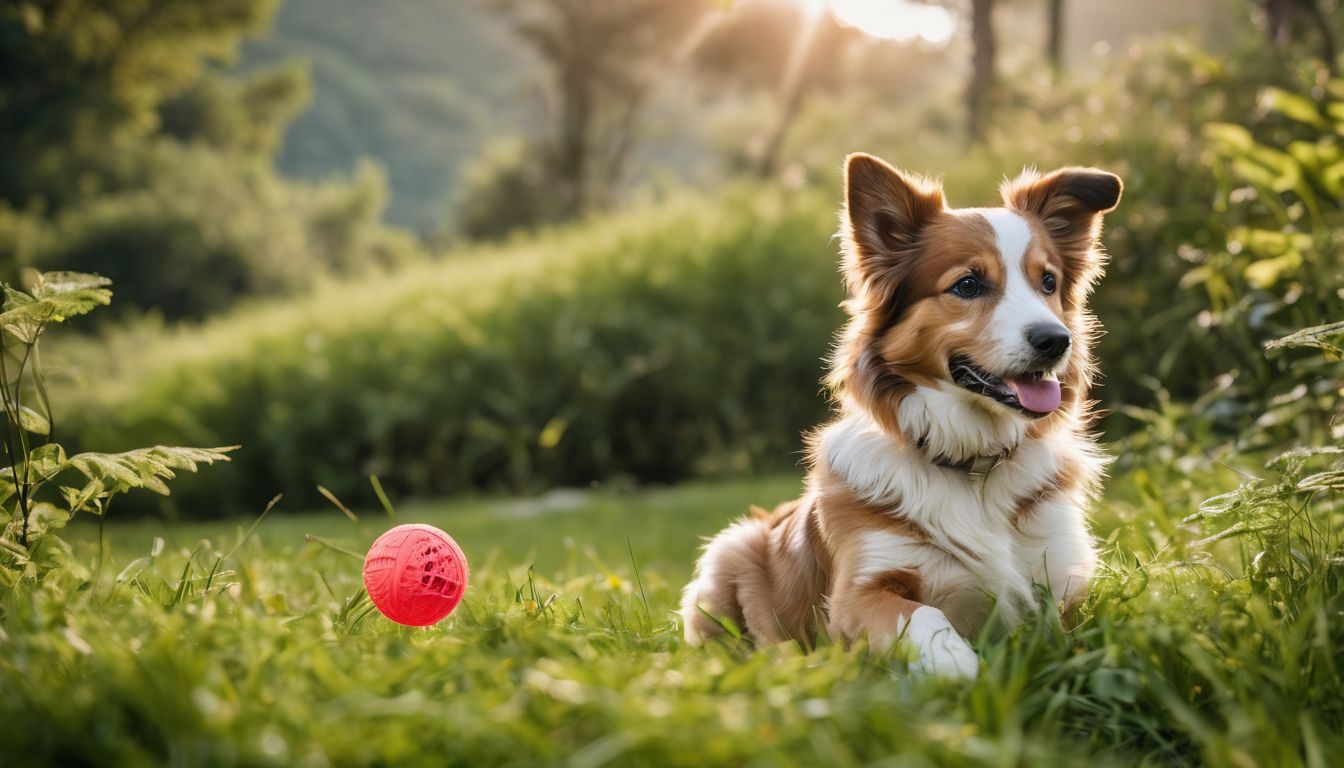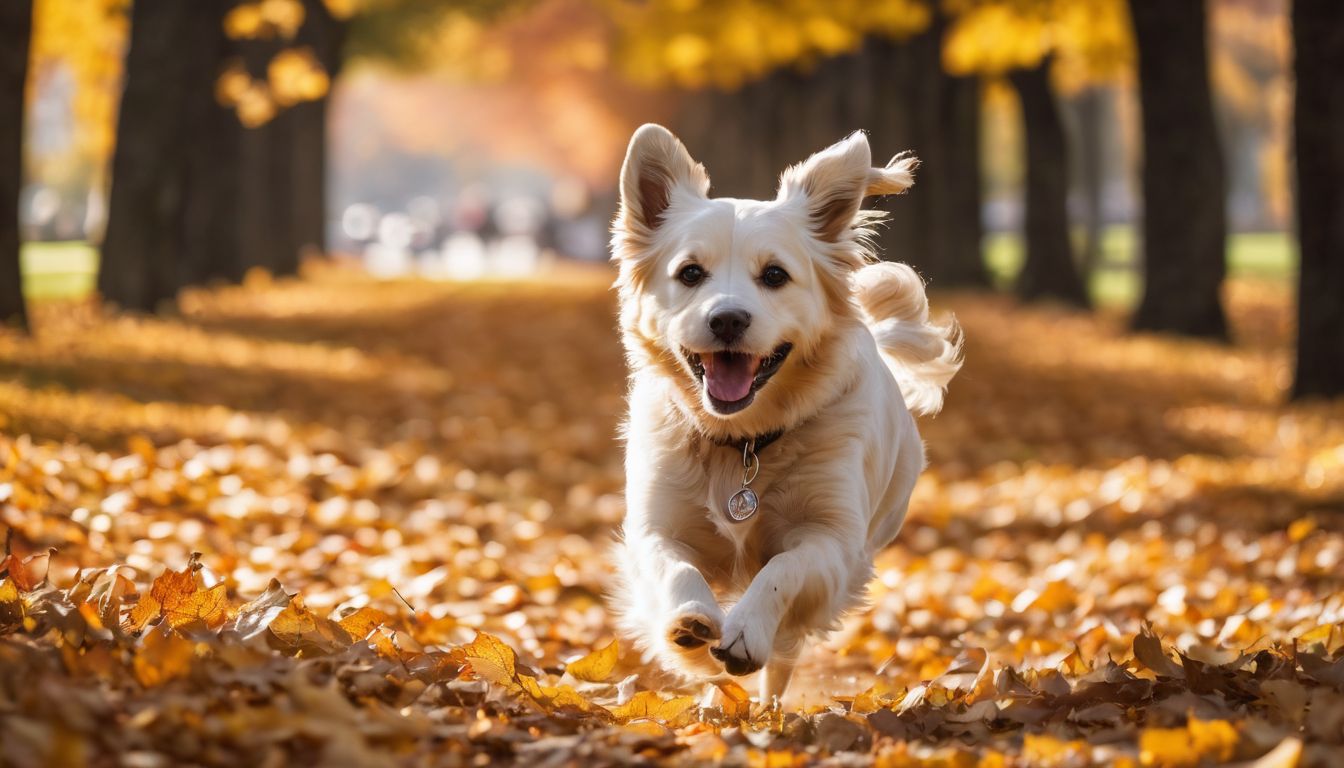Ensuring your pet’s safety at home is a concern shared by many caring owners. Surprisingly, a house can hide numerous hazards for our furry friends. Our guide will provide practical steps to transform your living space into a haven for pets.
Discover peace of mind with us!
Key Takeaways
- Secure storage spaces like drawers and cupboards with childproof latches to keep pets from harmful items.
- Store all toxic foods, chemicals, and small choking hazards out of pets’ reach to prevent ingestion accidents.
- Keep toilet lids down and bathroom doors closed to limit your pet’s access to potential dangers like medicines and cleaning products.
- Make sure rubbish bins have secure lids and store pantry items in pet – proof containers to avoid exposure to hazardous waste or toxic foods.
- Inspect outdoor areas, ensuring fences are hole-free, pools are fenced off, standing water is eliminated, and plants are non-toxic for a safer garden environment for pets.
Pet Safety in the Bedroom
Secure drawers and cupboards to prevent pets from accessing potentially harmful items. Keep dangerous items out of reach, and be mindful of choking hazards such as small toys or accessories.
Secure drawers and closets
Make sure drawers and closets are firmly fastened to prevent pets from prying them open. Curious animals often explore such spaces, putting themselves at risk of being trapped or ingesting harmful items stored inside.
Install locks or childproof latches on your storage areas to keep four-legged family members safe.
Choose environmentally friendly safety devices whenever possible to support conservation efforts while petproofing your home. Strong magnetic catches or pressure-mounted dividers can deter pets without causing harm or adding toxins to the environment.
Keeping bedrooms, playrooms, and other areas secure not only protects your pet’s health but also ensures a pet-safe home environment that aligns with eco-conscious values.
Keep dangerous items out of reach
Place harmful substances such as cleaning products, medications, and chemicals in secure cabinets or high shelves. Store small items that could pose a choking hazard, like hair accessories or coins, out of your pet’s reach.
Keep electrical cords and wires tucked away or use cord protectors to prevent chewing accidents.
Consider using childproof locks on drawers and cupboards where dangerous items are stored. Avoid leaving sharp objects like scissors and knives within your pet’s access. Be mindful of potential hazards in the garage or other areas where pets have access, ensuring all hazardous materials are safely secured.
Regularly check for any new hazardous items that may have been brought into the home.
Beware of choking hazards
Ensure pets cannot access small objects like buttons, coins, and jewellery. Keep electrical cords, plastic bags, and rubber bands out of reach. Cut food into small pieces to prevent choking.
Regularly check pet toys for signs of damage or wear and replace them when necessary. Supervise your pet during playtime with toys or chew treats. Consider using specially designed products to reduce the risk of choking hazards such as slow feeder bowls or puzzle feeders.
Always be vigilant about potential choking hazards that may harm your pet’s well-being. Maintain a tidy living space by keeping floors clear from small items and ensuring hazardous materials are safely stored away from curious paws.
Pet Safety in the Bathroom
Store medications and chemicals out of reach, and take extra care with harmful products like toothpaste and cosmetics. Keep toilets and showers safe for your pets to prevent accidents or ingestion of dangerous substances.
Store medications and chemicals safely
Keep medications and chemicals in closed cabinets or high shelves. Make sure to securely lock away any hazardous items out of your pet’s reach.
- Place all prescription and over-the-counter medications, vitamins, and supplements in a secured container or cabinet to prevent accidental ingestion by pets.
- Avoid leaving medication bottles on worktops or tables where pets can easily access them.
- Keep cleaning products, detergents, and other chemicals in locked cabinets or storage areas to prevent pets from coming into contact with toxic substances.
- Store hazardous items such as bleach, antifreeze, pesticides, and fertilisers in secure containers that are inaccessible to pets.
- Be mindful of potential hazards such as essential oils and liquid potpourri which could be harmful if ingested or come into contact with a pet’s skin.
Watch out for harmful products like toothpaste and cosmetics
Be cautious with harmful products such as toothpaste and cosmetics in your home to ensure the safety of your pets. These items often contain chemicals and ingredients that can be toxic to animals if ingested or exposed. Pet owners should take the following precautions:
- Store toothpaste, lotions, and cosmetics in cabinets or drawers that are inaccessible to pets.
- Check the ingredient lists of personal care products for substances that may be harmful to animals, such as xylitol in toothpaste.
- Keep bathroom doors closed to prevent pets from accessing these potentially hazardous items.
Keep toilets and showers safe for pets
Store toilet cleaners and other chemicals in secure cabinets to prevent accidental ingestion by pets. Ensure that the toilet seat is always kept down, and shower doors are closed to limit access for curious pets.
Consider using non-toxic cleaning products to maintain a safe environment for your pets.
Regularly inspect the bathroom floor for any potential hazards such as small items or hair ties that could pose a choking risk to pets. Supervise your pet during bath time to prevent them from drinking soapy water or getting into harmful products.
Pet Safety in the Kitchen
Be mindful of toxic foods and secure rubbish and pantry items to keep your pets safe from potential hazards. For more tips on pet safety in the home, continue reading our guide.
Be mindful of toxic foods
Be aware of toxic foods that can harm your pets. Ensure that they do not have access to the following items:
- Chocolate: Keep chocolate out of reach as it contains theobromine, which is toxic to dogs and cats.
- Grapes and raisins: These can cause kidney failure in pets, so avoid leaving them accessible.
- Onions and garlic: These can lead to anemia in pets if ingested, so store them securely.
- Xylitol: This artificial sweetener is found in many products like gum and sugar-free treats and is extremely toxic to pets.
- Avocado: The persin in avocados can cause vomiting and diarrhea in animals, so keep this out of their reach.
Secure trash and pantry items
- Keep rubbish bins securely lidded to prevent access to hazardous waste and harmful substances like spoiled food, chemicals, or packaging materials that could cause injuries or ingestion.
- Store pantry items in pet – proof containers or cabinets with locks to avoid your pets gaining access to potentially toxic foods such as chocolate, grapes, onions, and products containing xylitol.
- Dispose of food waste properly and promptly to prevent attracting pests and scavengers that pose a danger to your pets.
- Consider using natural pest deterrents and organic waste disposal methods to maintain a safe environment for your pets without the use of harmful chemicals or poisons.
- Regularly inspect and maintain pantry shelves and storage areas to ensure no spills or leaks occur that may be harmful if ingested by your pets.
- Keep cleaning supplies, including bleach, detergents, and disinfectants, in secure locations away from pets’ reach to avoid accidental poisoning or exposure to toxic substances.
Keep appliances and cords out of reach
When pet-proofing your home, it’s crucial to keep appliances and cords out of reach to prevent accidents. To keep your pets safe, follow these tips:
- Secure cords and wires from appliances using cord concealers or tucking them behind furniture.
- Store small appliances in cupboards or on high shelves to prevent pets from knocking them over.
- Use outlet covers or cord protectors to shield electrical outlets and cords from curious pets.
Pet Safety in the Yard
– Check fencing for holes and secure any toxic plants. Supervise pets around pools and standing water to prevent accidents. Ensure secure trash bins and fire pits to keep your yard safe for your pets.
Check fencing for holes and secure any toxic plants
Inspect the perimeter fencing for any holes or gaps that your pet could use as an escape route. Secure any hazardous plants in the garden, such as lilies, azaleas, and daffodils.
- Repair any damaged areas of the fence to prevent your pet from wandering away.
- Remove toxic plants from the garden and replace them with pet – friendly alternatives.
- Consider using natural deterrents like citronella or lemongrass to keep pets away from specific outdoor areas.
- Use pet – safe weed killers to maintain a safe environment for your pets.
Supervise pets around pools and standing water
When outdoors, watch pets closely around pools and any standing water to prevent accidents. Keep pets safe by incorporating the following measures:
- Install a secure fence around the pool area to prevent unsupervised access.
- Use pet – safe pool covers or nets to keep pets from falling into the water when unattended.
- Remove any water containers or objects that can collect rainwater, as they may pose drowning hazards.
- Train pets to stay away from the pool area using positive reinforcement techniques.
- Always supervise pets near ponds, lakes, or other bodies of water, and consider using flotation devices for added safety.
Ensure secure trash bins and fire pits
When ensuring pet safety in the garden, it is important to take precautionary measures around potential hazards like rubbish bins and fire pits. Here are some tips for ensuring pet safety around these areas:
- Securing Rubbish Bins: Use animal-proof lids or secure the lids with bungee cords to prevent pets from accessing harmful waste or consuming spoiled food.
- Proper Waste Disposal: Dispose of hazardous materials, such as cleaning agents and chemical products, safely and securely to prevent accidental ingestion by pets.
- Fire Pit Safety: Keep pets away from fire pits by installing barriers or using pet gates to create a safe distance between them and open flames.
- Clear Debris: Regularly clear the area around fire pits and rubbish bins to remove any potential hazards, such as sharp objects or toxic substances.
- Training and Supervision: Teach pets not to approach these areas, and always supervise them when they are outdoors near rubbish bins or fire pits.
- Check for Hazards: Periodically inspect the surroundings for any potential dangers, and promptly address any safety concerns that may arise around rubbish bins and fire pits.
Home Improvements for Pet Safety
– When making home improvements, consider the safety of your pets as well. This could include creating safe spaces for them indoors or outdoors, installing pet doors, building a catio, or even considering security measures like cameras to keep an eye on your pets.
Maintain safety during renovations
- Keep pets away from construction zones to prevent injuries from tools and materials.
- Use non – toxic paints and materials that are safe for pets if they accidentally ingest them.
- Create a safe and quiet space for your pet to retreat to during noisy renovations.
- Ensure proper ventilation to minimise exposure to dust and fumes which can harm your pet’s respiratory system.
- Monitor the use of power tools and machinery to prevent accidents involving your pet.
- Safely store tools, nails, and other small items that could pose a choking hazard to pets.
- Consider confining your pet in a safe area or with a trusted friend or family member during major renovations.
Create safe spaces for pets indoors and outdoors
Consider installing cameras or security measures
Install cameras or security measures to monitor your pet’s activities when you are away from home. These safety measures can provide peace of mind and help keep your pets secure. Additionally, consider reinforcing doors and windows to prevent animals from escaping, ensuring a safe environment for them in your absence.
Evaluate the need for surveillance devices and security features to safeguard against potential risks. Maintaining vigilance over your pet’s surroundings is crucial, especially if they are left alone at any point during the day.
By implementing such precautions, you can further enhance the safety and well-being of your pets while contributing to a sustainable living environment.
Install pet doors and build a catio
To further ensure the safety and well-being of your pets, consider installing pet doors to allow them access to secure outdoor spaces. This promotes exercise and mental stimulation while keeping them safe within the confines of your garden.
Additionally, building a catio can provide an enclosed area for cats to enjoy fresh air and sunshine without exposing them to potential dangers or risks outside.
Creating these designated areas grants pets freedom in a controlled environment, enhancing their overall quality of life. It also minimises the need for constant supervision, providing peace of mind for pet owners while supporting their furry friends’ physical and emotional needs as part of a pet-friendly home environment.
Conclusion
In conclusion, pet safety at home is essential for a happy and healthy environment. It’s crucial to take proactive measures in dogproofing your home and garden to prevent accidents.
By being mindful of potential hazards and making necessary adjustments, you can create a safe and pet-friendly space for your furry friends. Remember, the well-being of our pets depends on creating a secure and nurturing environment within our homes.
FAQs
1. What are the top pet safety tips for keeping my pets secure at home?
Top pet safety tips include pet-proofing your house, using home security systems that are safe around animals, and ensuring you have a safe and secure back garden.
2. How can I make sure my home environment is pet-friendly?
To create a pet-safe home environment, remove any home hazards for pets, like toxic plants or loose wires, and use pet safety products to protect them from harm.
3. Is it important to dogproof my house even if my dog is well-behaved?
Yes! Dogproofing your home helps prevent accidents by removing potential dangers; it’s a key part of being responsible for your pet’s health and wellbeing.
4. Are there particular measures I should take to ensure the safety of my pets in the car?
Definitely! To ensure animal safety on the go, use proper restraints like seat belts designed for dogs or travel crates secured safely in the vehicle.
5. Can childproofing supplies be used when creating a safer space for pets in the house?
Childproofing items can often double up as tools for keeping pets safe at home—think about latches on cupboards or bitter-tasting sprays to deter chewing.
6. Besides physical modifications to my house, how else can I contribute to indoor pet safety?
Understanding your pet’s behaviour is essential; provide adequate care through regular vet checks and stay alert to any changes that could indicate hidden dangers inside your house.





